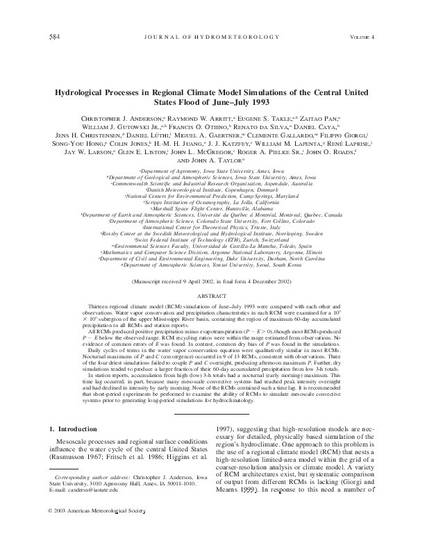
Thirteen regional climate model (RCM) simulations of June–July 1993 were compared with each other and observations. Water vapor conservation and precipitation characteristics in each RCM were examined for a 10° × 10° subregion of the upper Mississippi River basin, containing the region of maximum 60-day accumulated precipitation in all RCMs and station reports.
All RCMs produced positive precipitation minus evapotranspiration (P − E > 0), though most RCMs produced P − Ebelow the observed range. RCM recycling ratios were within the range estimated from observations. No evidence of common errors of E was found. In contrast, common dry bias of P was found in the simulations.
Daily cycles of terms in the water vapor conservation equation were qualitatively similar in most RCMs. Nocturnal maximums of P and C (convergence) occurred in 9 of 13 RCMs, consistent with observations. Three of the four driest simulations failed to couple P and C overnight, producing afternoon maximum P. Further, dry simulations tended to produce a larger fraction of their 60-day accumulated precipitation from low 3-h totals.
In station reports, accumulation from high (low) 3-h totals had a nocturnal (early morning) maximum. This time lag occurred, in part, because many mesoscale convective systems had reached peak intensity overnight and had declined in intensity by early morning. None of the RCMs contained such a time lag. It is recommended that short-period experiments be performed to examine the ability of RCMs to simulate mesoscale convective systems prior to generating long-period simulations for hydroclimatology.
Available at: http://works.bepress.com/eugene-takle/27/

This article is from J. Hydrometeor, 4, 584–598. doi: http://dx.doi.org/10.1175/1525-7541(2003)004<0584:HPIRCM>2.0.CO;2. Posted with permission.